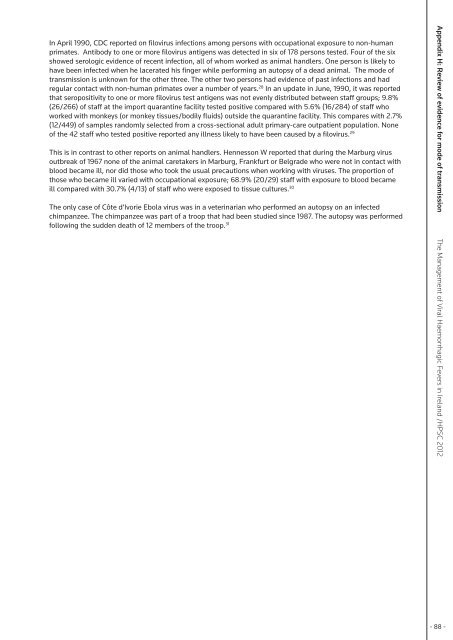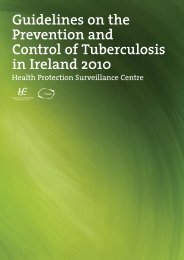Data evaluat<strong>in</strong>g transmission by the airborne route are scarce but the possibility <strong>of</strong> such transmission rema<strong>in</strong>s<strong>in</strong> rare <strong>in</strong>stances from patients <strong>in</strong> advanced stages <strong>of</strong> disease. 1,6 <strong>The</strong>re is also a potential risk to laboratoryworkers as small clouds <strong>of</strong> aerosolized viruses can be released <strong>in</strong> laboratory accidents, such as breakage <strong>of</strong>conta<strong>in</strong>ers with<strong>in</strong> centrifuges.H.4.1 Cases with unexpla<strong>in</strong>ed routes <strong>of</strong> transmissionIn most outbreaks <strong>of</strong> VHF, the exposures and routes <strong>of</strong> transmission have been established for most cases.However, there are some <strong>in</strong>stances where airborne or droplet transmission was a possibility.• In June 2009, a nosocomial outbreak <strong>of</strong> CCHF <strong>in</strong>volv<strong>in</strong>g 6 cases occurred <strong>in</strong> Iran, four <strong>of</strong> which werehealthcare workers. Two cases were <strong>in</strong>fected by percutaneous exposure, and three others were probably<strong>in</strong>fected through direct contact with blood, clothes and bed sheets. Of these three contacts, one wasadmitted to the same bed as the <strong>in</strong>dex case before it had been thoroughly dis<strong>in</strong>fected; one was exposed tothe blood <strong>of</strong> the <strong>in</strong>dex cases while wear<strong>in</strong>g perforated gloves; and the third had always worn <strong>in</strong>tact gloveswhile car<strong>in</strong>g for the <strong>in</strong>dex case, but did not always use a face shield or surgical mask and eye protection. 16• <strong>The</strong> first case <strong>of</strong> patient to patient nosocomial transmission <strong>of</strong> CCHF was described <strong>in</strong> 2006. <strong>The</strong> secondarycase was <strong>in</strong> a patient who had shared a room with the <strong>in</strong>dex case for 5 days before CCHF was diagnosed.<strong>The</strong> secondary case was considered to have a nosocomial <strong>in</strong>fection as she had been <strong>in</strong> hospital for 30 daysbefore the <strong>in</strong>dex case was admitted (<strong>in</strong>cubation period <strong>of</strong> CCHF: 3-5 days). It is not known for certa<strong>in</strong> how thesecondary case became <strong>in</strong>fected but it is postulated that it could have been through contact with <strong>in</strong>fectedblood or bodily fluids as the two patient shared the same toilet. Airborne transmission was considered aremote possibility. 17• Follow-up <strong>of</strong> contacts (n=157) <strong>of</strong> a symptomatic patient with Lassa fever who arrived by air <strong>in</strong> Germany <strong>in</strong>January 2000 revealed one probable secondary case. This person was a physician who had <strong>in</strong>serted an<strong>in</strong>travenous l<strong>in</strong>e, obta<strong>in</strong>ed blood samples and adm<strong>in</strong>istered an <strong>in</strong>fusion, did not wear gloves or a maskbut couldn’t recall contam<strong>in</strong>ation <strong>of</strong> the sk<strong>in</strong> with the patient’s blood. <strong>The</strong> doctor was also exposed to acough from the patient dur<strong>in</strong>g a throat exam<strong>in</strong>ation. <strong>The</strong>re was no evidence <strong>of</strong> any other possible routes <strong>of</strong>transmission. This probable secondary case was serological positive but was never symptomatic. 18H.4.2 Laboratory accidentsAirborne transmission is not thought to be the dom<strong>in</strong>ant route <strong>of</strong> transmission for VHFs, with the exception <strong>of</strong>mechanical aerosolisation dur<strong>in</strong>g medical or laboratory procedures. Arenaviruses are transmitted to humansby the <strong>in</strong>halation <strong>of</strong> small particle aerosols derived directly from rodent excreta or saliva conta<strong>in</strong><strong>in</strong>g the virusand these viruses pose a particular risk to laboratory workers where techniques present an opportunity for theaerosolisation <strong>of</strong> the virus. 19 <strong>The</strong>re have been two reported cases <strong>of</strong> laboratory-acquired Brazilian HF (Sabiavirus). <strong>The</strong> first was a laboratory technician who was <strong>in</strong>fected dur<strong>in</strong>g studies to characterise the virus, probablyby aerosol 20 , and the second was a virologist <strong>in</strong> Yale, US, who was <strong>in</strong>fected follow<strong>in</strong>g a leak <strong>in</strong> a high-speedcentrifuge. 21 Aerosol transmission is also the suspected source <strong>in</strong> six cases (one death) <strong>of</strong> Machupo virus up to1980. 22Transmission by aerosolisation <strong>in</strong> the laboratory and by needlestick <strong>in</strong>jury has also been documented for OmskHF, a member <strong>of</strong> the flaviviruses. 23 Up to 1979, 87 cases <strong>of</strong> laboratory-acquired <strong>in</strong>fections <strong>of</strong> Kyasanur ForestDisease were reported, with <strong>in</strong>halation <strong>of</strong> aerosols dur<strong>in</strong>g cultivation the most frequently reported route <strong>of</strong>24, 25transmission.Appendix H: Review <strong>of</strong> evidence for mode <strong>of</strong> transmission <strong>The</strong> <strong>Management</strong> <strong>of</strong> <strong>Viral</strong> <strong>Haemorrhagic</strong> <strong>Fevers</strong> <strong>in</strong> <strong>Ireland</strong>/HPSC 2012H.4.3 Transmission from non-human primatesAn outbreak <strong>in</strong>vestigation <strong>in</strong>to a comb<strong>in</strong>ed Simian haemorrhagic fever and Ebola virus <strong>in</strong>fection amongcynomolgus monkeys at a primate quarant<strong>in</strong>e facility <strong>in</strong> Reston, Virg<strong>in</strong>ia, United States, <strong>in</strong> 1989 suggested thatthe route <strong>of</strong> transmission between animals was aerosol or droplet, though there were no specific studies wereconducted at the time to <strong>in</strong>vestigate this feature. Other observations relat<strong>in</strong>g to the mode <strong>of</strong> transmission <strong>of</strong>Ebola virus dur<strong>in</strong>g the outbreak <strong>in</strong>cluded: direct contact was not necessary; blood transfer was not essential;throat swabs were <strong>of</strong>ten positive for Ebola virus and the virus was cultured repeatedly from ur<strong>in</strong>e and faeces. 26Johnson et al. (1995) reported aerosol transmission <strong>of</strong> Ebola virus to non-human primates <strong>in</strong> an experimentalprimate model. 27- 87 -
In April 1990, CDC reported on filovirus <strong>in</strong>fections among persons with occupational exposure to non-humanprimates. Antibody to one or more filovirus antigens was detected <strong>in</strong> six <strong>of</strong> 178 persons tested. Four <strong>of</strong> the sixshowed serologic evidence <strong>of</strong> recent <strong>in</strong>fection, all <strong>of</strong> whom worked as animal handlers. One person is likely tohave been <strong>in</strong>fected when he lacerated his f<strong>in</strong>ger while perform<strong>in</strong>g an autopsy <strong>of</strong> a dead animal. <strong>The</strong> mode <strong>of</strong>transmission is unknown for the other three. <strong>The</strong> other two persons had evidence <strong>of</strong> past <strong>in</strong>fections and hadregular contact with non-human primates over a number <strong>of</strong> years. 28 In an update <strong>in</strong> June, 1990, it was reportedthat seropositivity to one or more filovirus test antigens was not evenly distributed between staff groups; 9.8%(26/266) <strong>of</strong> staff at the import quarant<strong>in</strong>e facility tested positive compared with 5.6% (16/284) <strong>of</strong> staff whoworked with monkeys (or monkey tissues/bodily fluids) outside the quarant<strong>in</strong>e facility. This compares with 2.7%(12/449) <strong>of</strong> samples randomly selected from a cross-sectional adult primary-care outpatient population. None<strong>of</strong> the 42 staff who tested positive reported any illness likely to have been caused by a filovirus. 29This is <strong>in</strong> contrast to other reports on animal handlers. Hennesson W reported that dur<strong>in</strong>g the Marburg virusoutbreak <strong>of</strong> 1967 none <strong>of</strong> the animal caretakers <strong>in</strong> Marburg, Frankfurt or Belgrade who were not <strong>in</strong> contact withblood became ill, nor did those who took the usual precautions when work<strong>in</strong>g with viruses. <strong>The</strong> proportion <strong>of</strong>those who became ill varied with occupational exposure; 68.9% (20/29) staff with exposure to blood becameill compared with 30.7% (4/13) <strong>of</strong> staff who were exposed to tissue cultures. 30<strong>The</strong> only case <strong>of</strong> Côte d’Ivorie Ebola virus was <strong>in</strong> a veter<strong>in</strong>arian who performed an autopsy on an <strong>in</strong>fectedchimpanzee. <strong>The</strong> chimpanzee was part <strong>of</strong> a troop that had been studied s<strong>in</strong>ce 1987. <strong>The</strong> autopsy was performedfollow<strong>in</strong>g the sudden death <strong>of</strong> 12 members <strong>of</strong> the troop. 31Appendix H: Review <strong>of</strong> evidence for mode <strong>of</strong> transmission <strong>The</strong> <strong>Management</strong> <strong>of</strong> <strong>Viral</strong> <strong>Haemorrhagic</strong> <strong>Fevers</strong> <strong>in</strong> <strong>Ireland</strong> /HPSC 2012- 88 -
















